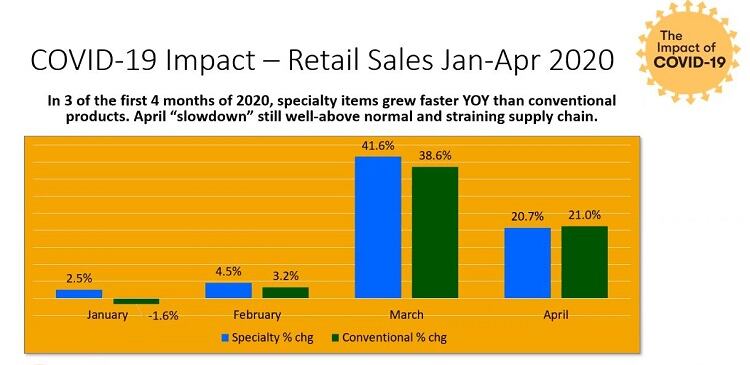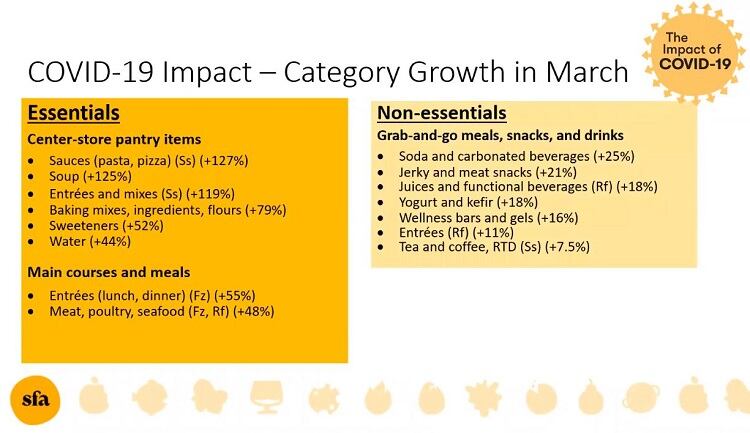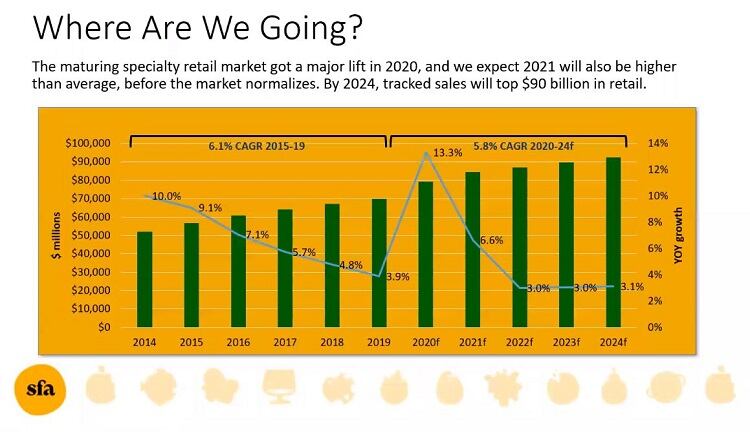“It’s been a very stable decade-long path where specialty products have grown 3x faster than the entire food and beverage market,” said David Lockwood, consulting director, Mintel, during SFA’s virtual state of the industry event this week.
Once pandemic shopping took full effect, however, conventional brands experienced an unprecedented resurgence, according to Lockwood.

“January started off pretty much as you would think – conventional not really growing, specialty growing a few percentage points. February ramped up a little bit and then March hits.”
Specialty food saw 41% year-over-year growth in sales for the Month of March and conventional grew 38%, noted Lockwood.
There was a step-down effect in April where specialty food sales grew by half as much (20.7%) while conventional grocery sales were slightly higher at 21%.
“That has almost never happened, and we believe there is something in that figure,” said Lockwood.
Well-known ‘inventory-rich’ brands are winning, for now
The months-long pandemic which is still sending lingering shockwaves across the food retail landscape sparked a resurgence of center-store pantry products, and in large part, big name conventional brands whose robust supply chains and inventories could – for the most part – keep up with consumer demand compared to many specialty products, said Lockwood.
“We’ve all seen the supply chain being massively overtaxed, and that’s led to persistent out of stocks, it’s also led to SKU reductions at the shelf."
Specialty brands were also hit hard by the decline in store foot traffic, he said.
“All of those things together really did impact new product discovery, which is enormous for specialty foods. That’s one of the reasons we exist here, and that became much harder during the pandemic,” said David Browne, a market research, retail & brand consultant.
Top growth categories
Despite headwinds, several specialty food categories are seeing extremely strong growth as consumers shift their eating habits and seek out more products they deem 'essential', according to Browne.
"To see the numbers is somewhat staggering," said Browne, noting that even established, developed $1bn categories such as sauces and soup grew by a whopping 127% and 125% compared to the year before.
"It’s kind of strange to be talking about categories that didn’t do so well – but were still posting 20% growth – but it’s all relative, and that’s the point we’re trying to make here. Sweet treats like cookies and desserts grew well, but these indulgences were not as critical [during the pandemic]," he said.

Forecast: A harder-hitting second wave?
“There’s no question that we’re still in a long-term food deflation atmosphere. Once we get through the pandemic, growth rates will be lower than they were coming into the pandemic, simply because that is the long-term trend,” said Lockwood.

In fact, Lockwood predicts that specialty foods will be challenged again when a second wave of the coronavirus inevitably hits.
“We believe that the most likely path in this virus, is that there will be a second wave and when that happens we feel that the economic stress on consumers will be higher than it has been in its first phase. And at that point, conventional groceries may outpace specialty foods; and that has never happened since we’ve been doing this report.”

